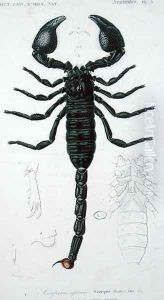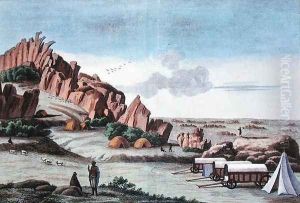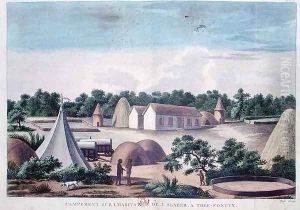Vaillant, Francois Le Paintings
Francois Le Vaillant, although not primarily known as an artist in the traditional sense, was a significant figure in the exploration and documentation of the natural world, which had a profound impact on natural history illustration. Born in Paramaribo, Suriname, in 1622, Le Vaillant was a French explorer, collector, and ornithologist. His work mainly involved the exploration of southern Africa, where he traveled extensively, documenting wildlife and particularly bird species, which later played a crucial role in the development of ornithology as a scientific discipline.
Le Vaillant is best remembered for his major contributions to ornithological art, through the illustrations in his published accounts of his journeys. His travels in Africa were documented in several works, the most famous being 'Voyage dans l'intérieur de l'Afrique' (Journey into the Interior of Africa) and 'Histoire Naturelle des Oiseaux d'Afrique' (Natural History of the Birds of Africa), published between 1796 and 1808, which were among the first comprehensive studies on African ornithology. These publications were richly illustrated with hand-colored plates that depicted the birds in vivid detail, bringing the exotic wildlife of Africa to the European audience for the first time.
Le Vaillant's approach to natural history illustration was innovative for his time. He insisted on portraying birds in their natural habitats, showing them amidst branches, foliage, and flowers, which was a departure from the more static and clinical illustrations common in scientific works of the period. This not only made his work artistically appealing but also provided early insights into the ecological contexts of the species he was documenting.
Despite his contributions to ornithology and natural history illustration, Francois Le Vaillant's work was not without controversy. His accounts were sometimes criticized for inaccuracies and exaggerations, and his methods of collecting specimens, which often involved extensive hunting, would be considered unethical by modern standards. However, his detailed observations and the sheer volume of specimens he collected contributed significantly to the field of natural history.
Francois Le Vaillant died in 1690. His legacy is a complex one, blending exploration, science, and art. Through his vivid illustrations and passionate descriptions of the African wilderness and its avian inhabitants, Le Vaillant played a crucial role in broadening the horizons of European science and art, inspiring further exploration and study of the natural world.


